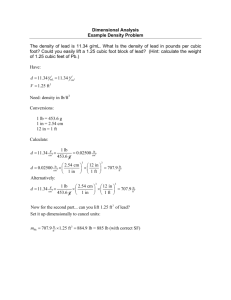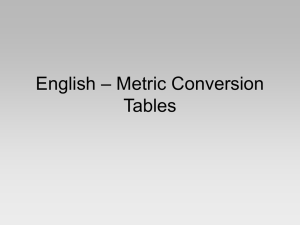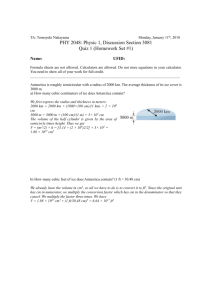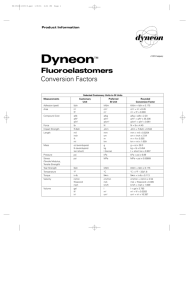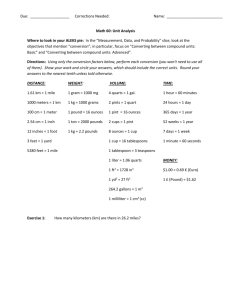Problem #1: A material will float on the surface of a liquid if the
advertisement
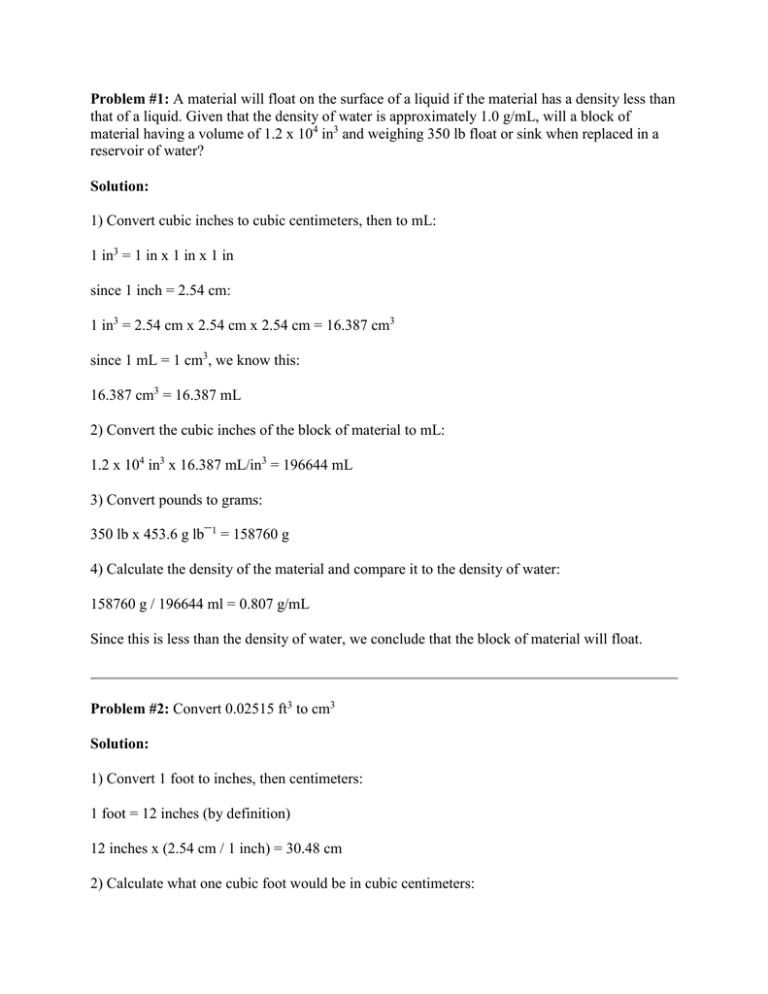
Problem #1: A material will float on the surface of a liquid if the material has a density less than that of a liquid. Given that the density of water is approximately 1.0 g/mL, will a block of material having a volume of 1.2 x 104 in3 and weighing 350 lb float or sink when replaced in a reservoir of water? Solution: 1) Convert cubic inches to cubic centimeters, then to mL: 1 in3 = 1 in x 1 in x 1 in since 1 inch = 2.54 cm: 1 in3 = 2.54 cm x 2.54 cm x 2.54 cm = 16.387 cm3 since 1 mL = 1 cm3, we know this: 16.387 cm3 = 16.387 mL 2) Convert the cubic inches of the block of material to mL: 1.2 x 104 in3 x 16.387 mL/in3 = 196644 mL 3) Convert pounds to grams: 350 lb x 453.6 g lb¯1 = 158760 g 4) Calculate the density of the material and compare it to the density of water: 158760 g / 196644 ml = 0.807 g/mL Since this is less than the density of water, we conclude that the block of material will float. Problem #2: Convert 0.02515 ft3 to cm3 Solution: 1) Convert 1 foot to inches, then centimeters: 1 foot = 12 inches (by definition) 12 inches x (2.54 cm / 1 inch) = 30.48 cm 2) Calculate what one cubic foot would be in cubic centimeters: 30.48 cm x 30.48 cm x 30.48 cm = 28317 cm3 3) Determine answer to problem: 0.02515 ft3 x (28317 cm3 / one ft3) = 712.2 cm3 Now, go to Google and type this in the search box: convert 0.02515 cubic foot to cubic centimeters Pretty amazing! Problem #3: Gasoline has a density of 0.76 g/mL. Find the mass of 4.25 gallons in pounds. Solution: 1) Convert g/mL to pounds per mL: 0.76 g/mL x (one lb / 453.59 g) = 0.0016755 lb/mL Convert lb/mL to lb/gal: 0.0016755 lb/mL x (3 785.4 mL/1 gal) = 6.34244 lb/gal Try this in Google: convert 0.76 g/mL to pounds/gallon 3) Find the mass of 4.25 gal: 6.34244 lb/gal x 4.25 gal = 27.0 pounds Problem #4: How many slugs are there in 54.29 kg? Hint: use Google to convert slugs to kilograms A slug is a very old school unit of mass. The ChemTeam has heard of it (as well as dyne and erg), but has never used it in a computation, either as a student or as a teacher. The ChemTeam would shout "Erg!" when putting the shot in high school and college. He thought this was quite funny, knowing that the erg is a unit of energy. The ChemTeam is easily amused! Problem #5: If a container measures 3.2 gallons of volume, how many liters does it occupy? Hie thee off to the great Googlizer! Problem #6: The three dimensions of a box are measured to be 1.3 in, 3.4 in, and 5.9 in. What is the volume of the box in liters? Solution: A video of the solution to problem #6 Problem #7: The density of water is 1.00 g/cm3. What is the density of water expressed in lb/ft3? Solution: 1) Convert 1.00 ft3 to cm3: one foot = 12 inches (by definition) 12 inches times (2.54 cm/inch) = 30.48 cm 30.48 cm x 30.48 cm x 30.48 cm = 28316.8466 cm3 2) Convert 28316.8466 grams to pounds: 28316.8466 grams divided by 453.59237 grams/pound = 62.43 pounds There are 62.43 lb/ft3 I used 28316.8466 g because water has a density of 1.00 g/cm3. Problem #8: Suppose your dorm room is 11.8 ft wide by 12 ft long and 8.5 ft high and has an air conditioner that exhanges air at a rate of 1200 L/min. How long would it take the air conditioner to exhange the air in your room once? Solution: 1) Convert feet to decimeters: from Google, one foot = 3.048 dm therefore: 11.8 ft times 3.048 dm/ft = 35. 9664 dm 12 ft times 3.048 dm/ft = 36.576 dm 8.5 ft times 3.048 dm/ft = 25.908 dm 2) Calculate the volume in cubic decimeters: 35. 9664 dm times 36.576 dm times 25.908 dm = 34082.156 dm3 3) Compute time required: 34082.156 dm3 / 1200 L/min = 28.40 min Remember, L = dm3, so those two units cancel exactly. Problem #9: Analysis of an air sample reveals that it contains 3.5 x 10-6 g/L of carbon monoxide. Express the concentration of carbon monoxide in lb/ft3. (1 lb = 453.6 g, 1 m = 3.27 ft) Solution: 1) Convert grams to pounds: 3.5 x 10-6 g/L times (1 lb/453.6 g) = 7.716 x10-9 lb/L 2) Construct the L to ft3 conversion: we know this by definition: 1 L = 1 dm3 we know this: 1 dm3 = 1 dm x 1 dm x 1 dm or expressed another way: 1 dm3 = 0.1 m x 0.1 m x 0.1 m we know this: 0.1 m = 0.327 ft Therefore: 1 L = 0.327 ft x 0.327 ft x 0.327 ft = 3.496 x 10-2 ft3 3) Convert L to cubic feet: 7.716 x10-9 lb/L times (1 L / 3.496 x 10-2 ft3) = 2.2 x 10-7 lb/ft3 (to two sig figs) Problem #10: Convert 22.43 gal/min to L/seconds. Solution: 1) Convert gallons to liters: 22.43 gal/min x (3.7854 L/gal) = 84.9067863 L/min All I did when I typed up this solution was go to Google and type "convert 22.43 gal to L" and it gave me the answer I pasted in above. 2) Convert minutes to seconds: 84.9067863 L/min x (1 min / 60 sec) = 1.415 L/sec Problem #10: Convert 35.50 mi/hr to km/s. Solution: 1) Convert hours to seconds: 35.5 mi/hr times (1 hr / 3600 s) = 0.009861 mi/s 2) Convert miles to km: 0.009861 mi/s times (1.609 km / mi) = 0.01587 km/s 3) Click this sentence. It will go to a Google conversion of this problem.
